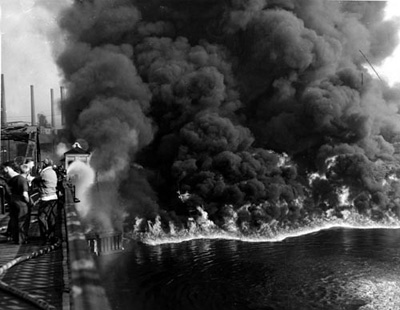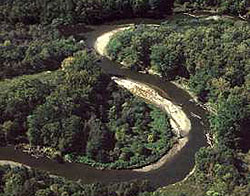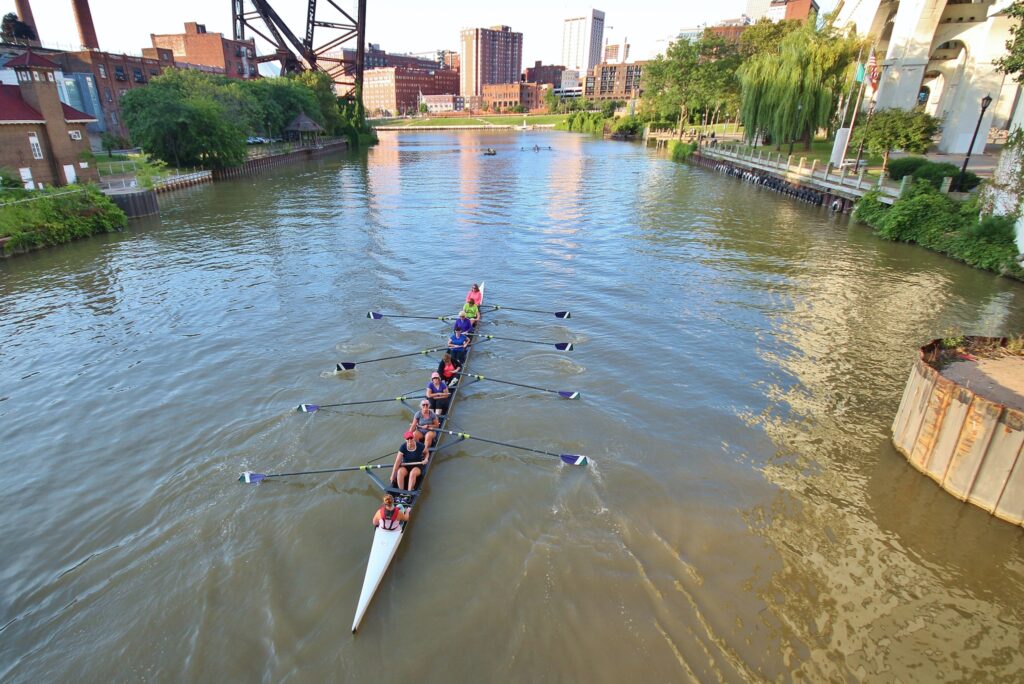What many people consider the precipitating event of the modern environmental movement occurred on June 22, 1969, when the Cuyahoga River in Cleveland, Ohio, burst into flames.

On that Sunday morning, floating debris, coated in oil, jammed under two railroad bridges that crossed the river. A spark from a passing train ignited the fire. Flames shot up as high as 50 feet into the air. A fireboat on the river quickly extinguished the flames, aided by fire crews working from the trestles. In a half-hour, the fire was out, causing $50,000 damage to the railroad bridges, but otherwise little noticed. The Cleveland Plains-Dealer didn’t even run a picture of the blaze.
But the event was hardly over. Amidst the growing concern about environmental problems around the country, Time Magazine ran a story on August 1, 1969 (“America’s sewage system and the price of optimism”) that made the Cuyahoga River famous. “Some river!” the author wrote, “Chocolate-brown, oily, bubbling with subsurface gases, it oozes rather than flows. ‘Anyone who falls into the Cuyahoga does not drown,’ Cleveland’s citizens joke grimily. ‘He decays.’”

The fire on June 22, however, was nothing new. A dozen fires on the river had been documented in the previous one hundred years. A fire in 1912 claimed five lives, and the biggest fire, in 1952, caused more than $1 million in damage. Photos of the 1952 fire are typically shown when the 1969 fire is discussed—because the 1969 fire was put out so quickly no photographs exist. In reality, the Cuyahoga River was one of the most polluted in the country at the time of the fire. The “river that burns” became symbolic of the environmental mess of the country—and especially industrial towns like those in Ohio. It earned Cleveland the unfortunate nickname of “the mistake by the lake”; Randy Newman’s song “Burn on, Big River,” immortalized the situation; and, even today, the Great Lakes Brewing Company produces Burning River Pale Ale to commemorate the event .
Ironically, the fire on June 22 should be recognized as the start of good things for the river. With at least a dozen precursors, the fire was the last, not the first, time the river burned. We have the burning of the Cuyahoga River to thank for an exclamation point on the growing narrative of environmental awareness of the times. Spurred by this event, the U.S. began passing environmental laws, like the Clean Water Act of 1970 (learn more about the Clean Water Act here). In the 15 years following the fire, the U.S. instituted a catalog of environmental agencies, laws and regulations that have seen our environment improve dramatically and continually.

And the Cuyahoga River has improved right along with the rest. Forty years after the fire, in 2009, Cleveland celebrated “The Year of the River.” From no life present in the river at the time of the fire, it now boasts more than 40 fish species including several—steelhead trout, northern pike—that require high-quality water conditions. Water quality has improved, but is not yet at the levels needed to allow all uses, like swimming. The Cuyahoga River is one of 43 Great Lakes Areas of Concern, denoted because of remaining environmental problems. Through the restoration group that monitors the Area of Concern, the river continues to gather the support, from government agencies and local organizations, needed to achieve a fully restored ecosystem.
References:
Cuyahoga River Area of Concern. Available at: http://www.cuyahogaaoc.org/index.html. Accessed June 23, 2017.
Time Magazine. 1969. America’s Sewage System and the Price of Optimism. Time Magazine, August 1, 1969. Available at: http://content.time.com/time/subscriber/article/0,33009,901182-1,00.html. Accessed June 23, 2017.
Cleveland Plain Dealer. 1969. Oil slick fire damages 2 river spans. Cleveland Plain Dealer, June 23, 1969. Available at: http://blog.cleveland.com/pdextra/2009/01/oil_slick_fire_damages_2_river.html. Accessed June 23, 2017.
Ohio History Central. Cuyahoga River Fire. Ohio History Central. Available at: http://www.ohiohistorycentral.org/w/Cuyahoga_River_Fire. Accessed June 23, 2017.
Rotman, Michael. 2010. Cuyahoga River Fire. Cleveland Historical, September 22, 2010. Available at: https://clevelandhistorical.org/items/show/63#.WU0sqWjys2w. Accessed June 23, 2017.
